New York Journal of Mathematics On the Bishop invariants of embeddings
advertisement
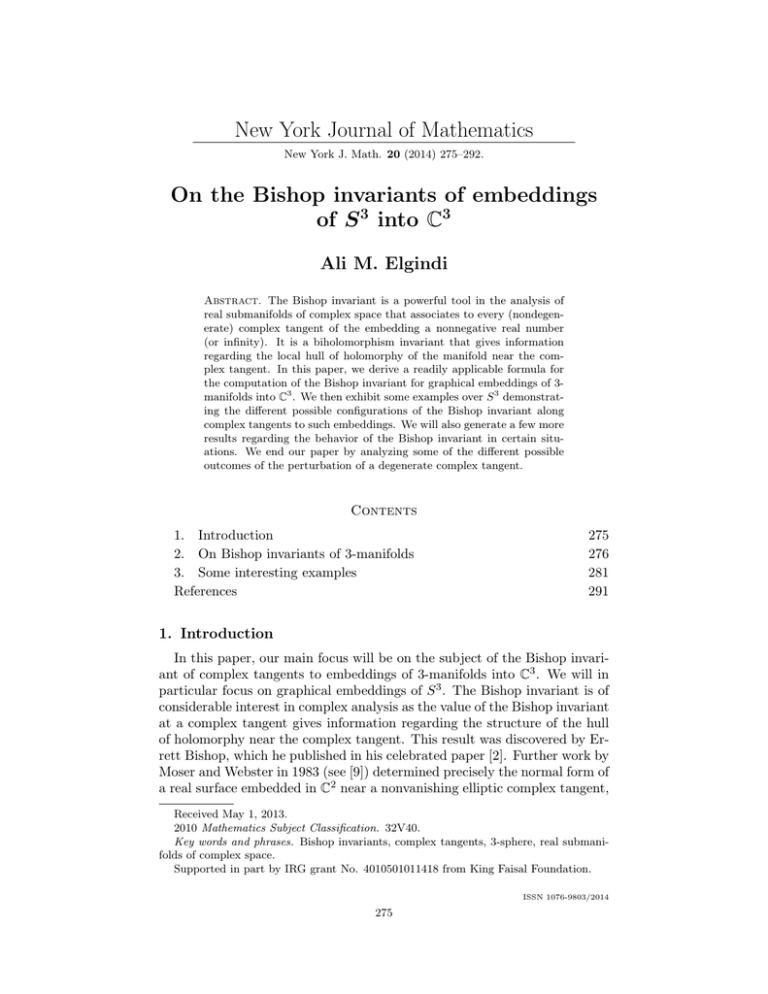
New York Journal of Mathematics
New York J. Math. 20 (2014) 275–292.
On the Bishop invariants of embeddings
of S 3 into C3
Ali M. Elgindi
Abstract. The Bishop invariant is a powerful tool in the analysis of
real submanifolds of complex space that associates to every (nondegenerate) complex tangent of the embedding a nonnegative real number
(or infinity). It is a biholomorphism invariant that gives information
regarding the local hull of holomorphy of the manifold near the complex tangent. In this paper, we derive a readily applicable formula for
the computation of the Bishop invariant for graphical embeddings of 3manifolds into C3 . We then exhibit some examples over S 3 demonstrating the different possible configurations of the Bishop invariant along
complex tangents to such embeddings. We will also generate a few more
results regarding the behavior of the Bishop invariant in certain situations. We end our paper by analyzing some of the different possible
outcomes of the perturbation of a degenerate complex tangent.
Contents
1. Introduction
2. On Bishop invariants of 3-manifolds
3. Some interesting examples
References
275
276
281
291
1. Introduction
In this paper, our main focus will be on the subject of the Bishop invariant of complex tangents to embeddings of 3-manifolds into C3 . We will in
particular focus on graphical embeddings of S 3 . The Bishop invariant is of
considerable interest in complex analysis as the value of the Bishop invariant
at a complex tangent gives information regarding the structure of the hull
of holomorphy near the complex tangent. This result was discovered by Errett Bishop, which he published in his celebrated paper [2]. Further work by
Moser and Webster in 1983 (see [9]) determined precisely the normal form of
a real surface embedded in C2 near a nonvanishing elliptic complex tangent,
Received May 1, 2013.
2010 Mathematics Subject Classification. 32V40.
Key words and phrases. Bishop invariants, complex tangents, 3-sphere, real submanifolds of complex space.
Supported in part by IRG grant No. 4010501011418 from King Faisal Foundation.
ISSN 1076-9803/2014
275
276
ALI M. ELGINDI
and in doing so determined precisely the local hull of holomorphy for such
a surface near a nonvanishing elliptic tangent. In 2009, X. Huang and W.
Yin were able to derive a complete set of invariants for a complex tangent of
vanishing Bishop invariant on a real surface embedded in C2 and resolve the
local hull of holomorphy; see [7]. Additionally, in 1984 Kenig and Webster
(in [5]) obtained results for the situation of an n-manifold M embedded in
Cn , in particular they constructed many possibly different Levi-flat manifolds bounded by M . In 1998, X. Huang (in [6]) was able to extend the
earlier results of Kenig and Webster in [5] to solve the “Bishop problem”
for n-manifolds embedded in Cn , in particular determining the local hull of
holomorphy near any elliptic tangent point.
For practical purposes of application however, it is unfortunate that the
derivation of the Bishop invariant can be found to be rather coarse and abstract, and not easily applicable for computation. In our paper, we will use
the work of Bishop and the later work of Webster in [10] to derive a new
formula for the Bishop invariant which can be used to easily compute the
Bishop invariant for graphical embeddings of 3-manifolds. We demonstrate
through several examples the flexibility of the Bishop invariant in this dimension, in particular we exhibit the possible behaviors of the Bishop invariant
along different configurations of complex tangents, which in the dimension
three will generically arise as knots or links. We also prove that along (almost) any surface of complex tangents, the Bishop invariant must be 12 . We
then analyze the effect of perturbing a degenerate complex tangent, both in
terms of the structure of the complex tangents to the perturbed embedding
and the corresponding behavior of the Bishop invariant.
2. On Bishop invariants of 3-manifolds
The Bishop invariant is a biholomorphism invariant associated to embeddings of real manifolds M n ,→ Cn . The Bishop invariant associates a real
number (or infinity) to every nondegenerate complex tangent point x (the
nondegeneracy condition will be given shortly).
More precisely, for such a complex tangent x ∈ M , there is an associated
number γ(x) ∈ [0, ∞], and we call x elliptic if γ(x) ∈ [0, 12 ), hyperbolic if
γ(x) ∈ ( 21 , ∞], and parabolic if γ(x) = 21 . It is a celebrated result of Bishop
in complex analysis that if a complex tangent x is elliptic then there exists a
family of analytic disks in Cn whose boundary circles all lie in M and so that
the disks converge to the point x. Building on Bishop’s results, many efforts
have been made to understand the hull of holomorphy of a real n-manifold
in Cn . This was the “Bishop problem,” and was completely answered in the
work of Kenig–Webster (in [4]) for the case of complex dimension two and
by Huang (in [6]) in any dimension.
In our paper, we wish to investigate if there is any topological or absolute
restrictions on the behavior of the Bishop invariant along curves of complex
tangents in S 3 . From our computations, there seems to be many possible
BISHOP INVARIANTS
277
behaviours of γ along any knot component. In particular, there are situations where γ is constantly parabolic, elliptic, or hyperbolic along a given
curve and an example is given where two knots are linking, one component
being elliptic and the other hyperbolic.
First, we must derive γ and find the means for practical computation.
As an alternative exposition on the Bishop invariant, we refer the reader
to Webster in [10]. For practical purposes, from here on we restrict our
considerations to 3-manifolds embedded in C3 .
Suppose S ,→ C3 can be given in holomorphic coordinates (z, w, ζ) by
~ = (r1 , r2 , r3 ) = 0},
S = {R
where ri : C3 → R are smooth and dr1 ∧ dr2 ∧ dr3 6= 0 (nowhere zero on S).
Let ∂r1 ∧ ∂r2 ∧ ∂r3 = Bdz ∧ dw ∧ dζ, where ∂ is the holomorphic Dolbeault
operator. Hence B : S → C is a smooth map, in fact,
∂(r1 , r2 , r3 )
.
B(x) = det
∂(z, w, ζ)
By construction, we see that B(x) = 0 if and only if x is a complex tangent.
In this paper, we will focus on the situation where S = graph(f |M ) is a
graph of a (sufficiently) smooth complex-valued function f over
M = {ρ(z, w) = 0} ⊂ C2 ,
~
where ∇(ρ)
6= 0 on M . In this case, we may write
S = {(z, w, ζ) | ρ(z, w) = 0 and ζ − f (z, w) = 0}.
With respect to our previous notation, write
r3 = ρ(z, w),
r1 = Re(ζ − f (z, w)),
r2 = Im(ζ − f (z, w)).
~ = 0}, where R
~ = (r1 , r2 , r3 ).
As before: S = {R
b where R = ζ − f (z, w)
Note we may change our coordinates to: (R, R, R)
b = ρ(z, w) without affecting the above computation for B (by properand R
ties of the complex determinant). Taking M = S 3 (ρ(z, w) = |z|2 +|w|2 −1),
we compute:
b
∂R
∂R
∂R
−fz −f z z
∂z
∂z
∂z
b
∂R
∂R
B = det ∂R
= det −fw −f w w
∂w
∂w
∂w
b
∂R
∂R
∂R
1
0
0
∂ζ
∂ζ
∂ζ
= z(f )w − w(f )z = −L(f ),
∂
∂
where L = z ∂w
− w ∂z
is the tangential Cauchy–Riemann operator to S 3 .
Note this is consistent as then {B = 0} = {L(f ) = 0}, and the zeros
of L(f ) form precisely the set of complex tangents to S = graph(f |S 3 ); see
Ahern and Rudin in [1].
We will now follow the work of Webster in [10] in defining the Bishop
invariant. Denote by ℵf = {B(x) = 0} the set of complex tangents to the
278
ALI M. ELGINDI
embedding S = graph(f |S 3 ). Suppose f is a generic map, in the sense that
the set of complex tangents is a smooth manifold of codimension two in S 3 ,
and so ℵf is some disjoint union of closed curves in S 3 , i.e., a link of knots.
Then for m ∈ ℵf , Hm (S) = Tm (S) ∩ J(Tm (S)) ⊂ C3 is a complex line. In
fact, we get a complex line bundle H → ℵf over the link ℵf . Now, tensoring
eachN
holomorphicLtangent space with C, we get the natural decomposition:
Hm C = Hm a Hm b , where Hm b = Hm a and Hm a is spanned by a vector
P
~ = 0 on ℵf .
X = ξi ∂z∂ i , which is given by the condition that X(R)
We call a complex tangent m ∈ M nondegenerate if XB(m) 6= 0 or
XB(m) 6= 0.
For such a nondegenerate complex tangent m, and define the Bishop
invariant at m to be
1 XB(m) ∈ [0, ∞].
γ(m) = 2 XB(m) Note that as the vector field X is defined up to X → cX, c a complex
constant. Further, it is a biholomorphism invariant, as was proven by Bishop
in [2], and demonstrated via this particular construction by Webster in his
paper [10].
In order to compute the Bishop invariant, we need to make sense of the
vector field X. We may compute:
−fw
ξ3 − ξ1 fz − ξ2 fw
−fz
1
~ = ξ1 −(f )z + ξ2 −(f )w + ξ3 0 = −ξ1 (f )z − ξ2 (f )w
X(R)
0
ξ1 z + ξ2 w
z
w
→
−
~
We wish to solve the equation: X(R)(m)
= 0 for all m ∈ ℵf . In
particular, we need to find ξ1 , ξ2 , ξ3 . (for a given function f ) so that the
above vector is zero at every point of ℵf . However, as we only need X to
evaluate on B, and B is a function solely in z, w (by construction), we find
that ξ3 is not relevant for our purposes and so we only need consider the
last two equations (which are devoid of mention of ξ3 ) to find ξ1 , ξ2 :
ξ1 (f )z + ξ2 (f )w = 0,
ξ1 z + ξ2 w = 0,
for all (z, w) ∈ ℵF .
Now, suppose (z, w) ∈ ℵf so that z 6= 0. Then we may write the second
equation: ξ1 = − wz ξ2 . Inserting this into the first equation, we get:
w
− ξ2 (f )z + ξ2 (f )w = 0.
z
Multiplying both sides by z, we obtain
ξ2 (−w(f )z + z(f )w )) = 0,
which is now a vacuous condition as the term in the parenthesis (i.e., everything excluding ξ2 ) is equal zero by condition that (z, w) ∈ ℵf . This is in
BISHOP INVARIANTS
279
fact consistent, as there is a complex line of possible candidates for X, in
particular any nowhere-zero complex function times a suitable X will also
generate the complex tangent space.
In particular, we find:
w ∂
∂
∂
X = − ξ2
+ ξ2
+α
z ∂z
∂w
∂ζ
for any nowhere-zero (in a neighborhood of (z, w) ∈ ℵf ) complex function
ξ2 and some function α, which is completely determined from ξ2 .
Taking ξ2 = z (remember we assume z 6= 0), we may take X to be
X = −w
∂
∂
∂
+z
+α .
∂z
∂w
∂ζ
Note if z = 0 this would imply that |w| = 1 (since we are in S 3 ), and
the above system of equations above would imply that ξ2 = 0 which means
∂
∂
+ α ∂ζ
would generate the complex tangent space. Hence, our
X = −w ∂z
above choice for X will in fact work at any complex tangent (z, w) ∈ ℵf .
Our computation of interest is X(B), where B = −L(f ), strictly a function in z, w. We see now why the function α is irrelevant to our considerations. But one can easily see that X, acting on functions g solely of z, w,
acts as
∂g
∂g
+z
= −L(g),
X(g) = −w
∂z
∂w
Hence, we see that
2
X(B) = X(−L(f )) = −L(−L(f )) = L (f )
by linearity of X and by the simple fact that: L(f ) = L(f ).
Further, we see that
X(B) = −L(−L(f )) = L(L(f )) = L(L(f )).
In fact, we are only interested in the norms of the above functions X(B)
and X(B), so we may take their conjugates:
|X(B)| = X(B) = L2 (f ) ,
X(B) = L(L(f )) ,
both of which are clear by our above observations. Hence, we find a new
formula for the Bishop invariant:
1 L2 (f )
,
γf = 2 L(L(f ))
which is a more closed and direct formulation (for graphical embeddings).
Theorem 1. Let G : S 3 ,→ C3 be a “graphical embedding”; i.e.,
G = graph(g|S 3 ),
280
ALI M. ELGINDI
for some g : C2 → C smooth (at least C 2 ). Then for any complex tangent
(z, w) ∈ ℵg , we may write the Bishop invariant as:
1 L2 (g)
(z, w) ∈ [0, ∞],
γg (z, w) = 2 L(L(g))
where the complex tangent is degenerate if both the numerator and dominator
are zero.
We remark that this is a biholomorphic invariant as it is derived directly
from the standard formulation of Bishop (in [2]) and the later work of Webster (in [10]).
Let us now make a note of the value of the Bishop invariant at a complex
tangent x ∈ ℵf which lies on a surface of complex tangents.
Assume that ℵf = {L(f ) = 0} ∩ S 3 contains a surface, that is, a codimension 1 submanfiold of S 3 . We will assume the situation that L(f ) is a real
function, or a complex function times a real function. We say this surface is
of standard type. Moreover, if ℵf contains a surface which contains x but no
other complex tangent component contains x (i.e., x is not the intersection
of a surface complex tangent component and a curve complex component,
for example), we may write L(f )(z, w) = cr(z, w)g(z, w), where r : C2 → R
is real and r(x) = 0 but g(x) 6= 0, and c ∈ C. We call such x nonsingular.
We then compute:
L2 (f )(z, w) = L(L(f ))(z, w) = L(cr(z, w)g(z, w))
= cg(z, w)L(r(z, w)) + cr(z, w)L(g(z, w)).
Evaluating at x,
L2 (f )(x) = cg(x)L(r)(x) + cr(x)L(g)(x) = cg(x)L(r)(x)
since r(x) = 0. Similarly, we see that
L(L(f ))(x) = cL(rg)(x) = cr(x)L(g)(x) + cg(x)L(r)(x) = cg(x)L(r)(x).
Further, as r is real, it is clear that: L(r) = L(r). Hence, we compute the
Bishop invariant at x:
1 L2 (f )
1 |cg(x)| |L(r)(x)|
(x) =
.
γf (x) = 2 L(L(f ))
2 |cg(x)| L(r)(x)
But we know cg(x) 6= 0, so they cancel and by our above remark the
resulting numerator and denominator functions are conjugate (and hence
have the same norm):
γf (x) =
Hence, we have proven:
1 |L(r)(x)|
1
= .
2 L(r)(x)
2
BISHOP INVARIANTS
281
Theorem 2. Let E : S 3 ,→ C3 be a graphical embedding. Then any (nonsingular) complex tangent lying on a surface of complex tangents of standard
type must be parabolic (and in particular, with nondegenerate Bishop invariant).
Surfaces may arise as complex tangents only in nongeneric situations (only
for a subset of embeddings of measure zero), but arise in many approachable
examples; perhaps the simplest situation is when g(z, w) = zw, where it is
easy to see that the embedding under the graph of g will give rise to complex
tangents precisely along the torus: T = {(z, w) | |z|2 = |w|2 = 12 } ⊂ S 3 ,
all of which are parabolic of course by our above result (there are no other
components of complex tangents to need to worry about singularities).
3. Some interesting examples
Let us now do some examples for the generic situation, i.e., where we
have (unions) of closed curves as the complex tangents, to point out the
numerous configurations and topological flexibility for the behavior of the
Bishop invariants in the generic situation.
Example 1. Here we will exhibit an embedding (of S 3 ) that admits a curve
of complex tangents which is purely parabolic. Note this is in general a very
rare situation as it requires the Bishop invariant to take value precisely 12 at
every point of the curve.
Let f (z, w) = 12 z 2 + w. Then the embedding F = graph(f |S 3 ) has its
complex tangents precisely where L(f ) = 0.
Here L(f ) = wz − z, and we further compute:
L(L(f )) = w2 ,
L(L(f )) = −w − z 2 .
Now, ℵf = {L(f ) = 0} ∩ S 3 . But note that L(f )(z, w) = 0 implies that
zw = z. Taking the norm of both sides, we find that
|z| |w| = |z| .
There are now two cases: |z| = 0 or |z| =
6 0. If |z| = 0, this implies
that z = 0 and |w| = 1 on S 3 , resulting in a great circle. Assuming |z| =
6
0, we may divide both sides of the above equation by |z| to obtain that:
|w| = 1 once again. Hence, we find that the set of complex tangents to this
embedding will form exactly the great circle |w| = 1 in S 3 . In our notation,
we write
ℵf = {(0, w) | |w| = 1}.
We compute the Bishop invariant along this curve:
1 |w|2
1 L2 (f )
1 w 2 1
=
(0, w) = γf (0, w) = =
2
2 L(L(f ))
2 −w − z 2 |w|
2
as |w| = 1.
282
ALI M. ELGINDI
Hence, we see that every point on the curve ℵf is parabolic. Hence,
ℵf ⊂ S 3 is a great circle which is purely parabolic with respect to this
particular embedding.
Example 2. We will now generalize the above Example 1 to construct
embeddings admitting constant Bishop invariant of any prescribed value
along the curve of complex tangents.
Let f (z, w) = αz 2 + w, for any fixed α ≥ 0 (finite). We compute:
L(f ) = 2αwz − z.
Thus,
L(L(f )) = 2αw2 ,
L(L(f )) = −w − 2αz 2 .
First, to find the set of complex tangents: ℵf = {L(f ) = 0} ∩ S 3 , we solve
the equation
2αwz = z.
First, if α = 0, we get only one curve of complex tangents corresponding to
the equation z = 0 on S 3 .
Now, assume α > 0. Proceeding as before, we have the two cases: z = 0
or z 6= 0.
If z = 0, we obtain the great circle: {(0, w) | |w| = 1}. Call this curve of
complex tangents ℵ1 .
If z 6= 0, we may take the norm of both sides of the above equation and
1
. This gives rise to a second
divide both sides by |z| to find that: |w| = 2α
curve of complex tangents, which we denote by: ℵ2 .
Let us consider the first curve, that is ℵ1 . To compute the Bishop invariant
along this curve,
1 2αw2 1 L2 (f )
1 2α |w|2
=
(0, w) = =α
γf (0, w) = 2 L(L(f ))
2 −w − 2αz 2 2 |w|
since |w| = 1 and z = 0.
Hence, ℵ1 is a curve of complex tangents to the embedding given by f
whose Bishop invariant is constant at α, which was an arbitrary positive
number.
We may also compute the Bishop invariant along the curve ℵ2 :
1 2αw2 |w|2
= α
γf = w + 2αz 2 .
2 −w − 2αz 2 However, on ℵ2 we know that 2αwz = z which implies that 2αz 2 =
a result,
1
1
w + 2αz 2 = (|w|2 + |z|2 ) = .
w
w
|z|2
w .
As
BISHOP INVARIANTS
Hence
283
|w|2
1
γf = α 1 = α |w|3 =
8α2
w
1
since |w| = 2α
on ℵ2 .
We may then conclude:
• If 0 < α < 21 , we obtain an elliptic curve ℵ1 and a hyperbolic curve
ℵ2 of constant Bishop invariant as described above.
• If 12 < α < ∞, we get a hyperbolic curve ℵ1 and an elliptic curve ℵ2
of constant Bishop invariant.
• If α = 0, we get a single curve of elliptic complex tangents with
Bishop invariant 0.
• If α = 21 , we get the situation of Example 1, where we have exactly
one curve of complex tangents which is purely parabolic.
Finally, for sake of completeness, we find an embedding of S 3 which admits
complex tangents which are hyperbolic of Bishop invariant ∞. Let f (z, w) =
w2 . Then
L(f ) = −2zw,
and hence the set of complex tangents to this embedding will form two great
circles:
ℵ1 = {(0, w) | |w| = 1},
ℵ2 = {(z, 0) | |z| = 1}.
We further compute:
L(L(f )) = 2z 2 ,
L(L(f )) = −2w2 .
The Bishop invariant to this embedding at a complex tangent is given by
γf (z, w) =
1 |z|2
.
2 |w|2
Hence, ℵ1 consists of complex tangents which are elliptic of constant Bishop
invariant 0, and ℵ2 consists of complex tangents which are hyperbolic of
constant Bishop invariant ∞.
Example 3. Here we exhibit a collection of five great circles that form the
set of complex tangents (all nondegenerate) to some embedding of S 3 . Let
f (z, w) = z 2 w + w2 z. We compute:
L(f ) = 2zw2 − 2wz 2 ,
L(L(f )) = 2w3 + 2z 3 ,
L(L(f )) = −4(w2 z + z 2 w).
We note that ℵa = {(0, w)}, ℵb = {(z, 0)} ⊂ ℵf , and as L(L(f )) 6= 0,
L(L(f )) = 0 at all points of either set, we see that these two components
consist purely of complex tangents of hyperbolic type-∞.
284
ALI M. ELGINDI
Now suppose z, w 6= 0. It is direct to see that
z3 =
1 − |w|2 3
w .
|w|2
Taking norm (squared) of both sides we get a polynomial in x = |w|2 :
x2 (2x3 − 5x2 + 4x − 1) = 0,
whose only solutions are: x = 0, 12 , 1. Note that the solutions x = 0, x = 1
correspond exactly to ℵb , ℵa , respectively.
If |w|2 = 12 , we see that we get three additional curves of complex tangents:
2 1
,
ℵ1 = (z, z) |z| =
2
1
2
2πi/3 ℵ2 = (z, ze
) |z| =
,
2
1
ℵ3 = (z, ze4πi/3 ) |z|2 =
.
2
Let (z, z) ∈ ℵ1 . Then
1 2w3 + 2z 3 1 2z 3 1
= = .
γf (z, z) = 2
2
2 4(w z + z w)
4 2z |z|2 4
Hence, every complex tangent in ℵ1 is elliptic with Bishop invariant 14 . Further, it is easy to see that complex tangents ℵ2 , ℵ3 has the same Bishop
invariants as the complex units factor out of the denominator and have no
effect (norm = 1).
Example 4. We now consider Bishop invariants along torus knots. For
more information on torus knots, we refer the reader to Milnor in [8]. Let
Tp,q = {z p = wq } ∩ S 3 be the standard (p, q)-torus knot, where (p, q) are
relatively prime natural numbers. We may readily graph T2,3 using software
like Mathematica (via stereographic projection).
Note that Tp,q arises precisely as the set of complex tangents to the graph
of f (z, w) = z p−1 w + wq−1 z, i.e., L(f ) = z p − wq . But this is a holomorphic
function, so L(L(f )) = 0 and further: L(L(f )) = pwz p−1 + qzwq−1 which
with a parametrization for Tp,q one can show is never zero for (z, w) ∈
Tp,q . Hence, every point of Tp,q is an elliptic complex tangent with Bishop
invariant 0.
One can extend this to general complex tangent knots arising as intersections of holomorphic algebraic sets in C2 intersect with S 3 to see that if a
complex tangent is nondegenerate, it must have Bishop invariant 0.
Example 5. Here we exhibit an embedding whose complex tangents make
two (knot) components who link (doubly), yet one curve consists of elliptic
complex tangents, and the other consists of hyperbolic complex tangents.
BISHOP INVARIANTS
285
Let f (z, w) = zw2 + zw. We compute:
L(f ) = −2wz 2 − 2 |z|2 + 1,
and so we see that L(f ) = 0 if and only if
w=
1 − 2 |z|2
.
2z 2
Taking norms of both sides, we get the polynomial equation in x (= |z|2 ):
4x3 − 4x + 1 = 0,
whose only (relevant) solutions are: x = .27, .838. Let α1 = .27, α2 = .838.
Then it is clear that
ℵf = ℵ1 ∪ ℵ 2
where:
1 − 2αi 2
ℵi =
z,
|z| = αi .
2z 2
Using stereographic projection through the point (0, 1) ∈ S 3 (which both
curves avoid), we may plot the curves ℵ1 , ℵ2 in R3 , and there-in it is clear
that ℵ1 , ℵ2 are knots (topologically equivalent to circles) and link together
with linking number 2 (via Mathematica).
In particular, this gives us an example of a nonsimple link arising precisely
as the set of complex tangents to an embedding.
Now, let’s compute the Bishop invariants of the complex tangents. We will
investigate both curves simultaneously by considering α = |z|2 in general.
We find
!
1 − |z|2
3
2
−w
L(L(f )) = 2z − 2wz = 2z(z − w) = 2z
2w
=
2z
2z |z|2
(1 − 2 |z|2 − |w|) = −
,
w
w
w
L(L(f )) = 4w2 z + 2wz = 2w(2wz + z) = 2 (2wz 2 + |z|2 )
z
w
2
= 2 (1 − |z| ).
z
Hence
3
2 |z|
1
|z|4
1 α2
1
|w|
γf (z, w) =
=
=
.
2
2
2
2 2 |w|(1−|z| )
2 |w| (1 − |z| )
2 (1 − α)2
|z|
On ℵ1 , α ≈ .27 and hence γf ≈ .068 on ℵ1 , i.e., ℵ1 consists of elliptic
complex tangents.
On ℵ2 , α ≈ .838 and hence γf ≈ 13.38 on ℵ2 , i.e., ℵ2 consists of hyperbolic
complex tangents.
286
ALI M. ELGINDI
The flexibility demonstrated through the examples above should hardly
be a surprise, as the Bishop invariant is a local biholomorphism invariant
and we expect the behavior of γ on one component to be independent of
any other component.
In fact, as we can construct unions of components of complex tangents
via multiplication of relevant polynomials (at least in H, which we may
then “push-forward” to S 3 per our previous constructions), and if we take
L(f ) = gh, where g(x) = 0, h(x) 6= 0, then in the computation of γf (x) any
mention of h cancels out:
L2 (f )(z, w) = L(L(f ))(z, w) = L(h(z, w)g(z, w))
= g(z, w)L(h(z, w)) + h(z, w)L(g(z, w)).
Evaluating at x,
L2 (f )(x) = g(x)L(h)(x) + h(x)L(g)(x) = g(x)L(h)(x)
as h(x) = 0.
Similarly, we see that:
L(L(f ))(x) = L(gh)(x) = h(x)L(g)(x) + g(x)L(h)(x) = g(x)L(h)(x).
Hence, we compute the Bishop invariant at x:
1 L2 (f )
1 |g(x)| |L(h)(x)|
1 |L(h)(x)|
(x) =
= ,
γf (x) = 2 L(L(f ))
2 |g(x)| L(h)(x)
2 L(h)(x)
since we know that g(x) 6= 0 and as such the terms |g(x)| cancel out. Hence,
the function g has no effect on the computation of the Bishop invariant.
As a result, we may conclude that the Bishop invariant is only dependent
on the function that gives rise to the component of complex tangents that
contains x. Hence, we have proven (at least for graphical embeddings):
Theorem 3. Let F = graph(f ) be a graphical embedding. Then behavior of
the Bishop invariant on any component of complex tangents is independent
of the behavior on other components and only dependent on the summand
of L(f ) that gives rise to the particular component.
In light of the theorem and our examples above, we may remark (a bit
imprecisely):
Remark. The linking of two curve components of complex tangents puts
no restriction on the behavior of the Bishop invariant along the two curves.
Example 6. We have thus far given examples of embeddings who give rise
to knots as complex tangents, links of knots, surfaces, and unions there-in
(even singular). Here we give an example of an embedding of S 3 who has
precisely one complex tangent point.
Let f (z, w) = z. We note that H = graph(f |H ) gives a totally real embediz
ding of H. Consider f ◦ψ : S 3 \{(0, 1)} → C, in particular: f (ψ(z, w)) = w−1
.
BISHOP INVARIANTS
287
3
Let q = qf 3 = iz(1−w)
which is now continuously differentiable on S 3 (in
w−1
particular, at (0, 1)).
We are assured by our work in [3] that Q = graph(q|S 3 ) will give an
embedding of S 3 of class C 1 with sole complex tangent at (0, 1). For the
sake of completeness, we check:
L(q) = −iw
(1 − w)3
(1 − w)3
.
+ i |z|2
1−w
(1 − w)2
Note both terms are continuous at (0, 1) and take value 0 there, in particular (0, 1) is a complex tangent of the embedding. Now to check there
are no more complex tangents, assume we are away from w = 1.
Then L(q) = 0 if and only if: |z|2 − w(1 − w) = 0 if and only if: w =
|z|2 + |w|2 = 1, which contradicts our above assumption that we are away
from (0, 1).
Hence, the only complex tangent to the C 1 embedding Q is (0, 1). As
such, there exists embeddings of S 3 ,→ C3 who have complex tangents only
at a single point.
Further, a direct computation gives us that the Bishop invariant at this
point is degenerate, i.e., the dominator and numerator must both be zero;
see below.
We were unsuccessful in proving the degeneracy of the Bishop invariant at
a general isolated complex tangent to an embedding, however our attempts
left us with confidence with which we claim:
Conjecture. An isolated complex tangent to an embedding of a 3-manifold
into C3 must have degenerate Bishop invariant.
We now refer the reader to our paper in [3] where we derived certain
functions to construct (graphical) embeddings S 3 ,→ C3 taking complex
tangents along a knot (link) of any prescribed type. As we found, all our
constructed embeddings must assume a degenerate complex tangent at the
point (0, 1). Namely, consider maps:
n+r
f (z, w) = (1−w)
(1−w)n p(z, w) for some complex polynomial p of degree n.
Then we compute:
(1 − w)n+r
L(f )(z, w) = L
p(z, w)
(1 − w)n
(1 − w)n+r
(1 − w)n+r
=
L(p)(z,
w)
−
n
zp(z, w)
(1 − w)n
(1 − w)n+1
which is zero at the point (0, 1).
In the computations of L(L(f )), L(L(f )), we find that
L(L(f )) =
(1 − w)n+r
g(z, w)
(1 − w)n+2
288
ALI M. ELGINDI
for some polynomial g, and similarly for L(L(f )). Taking r > 2, we see that
both must evaluate to be zero at the point (0, 1). Note we must take r > 2
for the Bishop invariant to be defined.
Hence our derived embeddings necessarily come with degeneracy at the
point (0, 1). However, by Sard’s theorem, perturbing our maps f (z, w) will
generically (almost always) give rise to an embedding with solely nondegenerate complex tangents, however in doing so we may add to the topology of
the tangents. We may also keep the perturbation “small”, so that we may
assume (again by Sard’s theorem) that the structure of the complex tangents
away from an arbitrarily small neighborhood of (0, 1) is not affected.
Let us now do some examples where we perturb functions of the prescribed
type above and see what happens to the set of complex tangents. Note
that holomorphic terms are ignored by the CR-operator so we restrict our
attention to polynomials of purely nonholomorphic terms. In particular, let
us continue the above Example 6.
4
Example 7. Here for simplicity write: f (z, w) = z (1−w)
1−w . Then as we
3
showed above, graph(f )|S 3 ⊂ C assumes precisely one complex tangent
point at (0, 1). Take the perturbation
4
(1 + − w)
fe(z, w) = z
1+−w
for > 0 arbitrarily small. Then we compute (and simplify):
(1 + − w)4
(1 + − w)4
−w
2
(1 + − w)
1+−w
4
(1 + − w)
=
(− |z|2 − w(1 + − w)
(1 + − w)2
(1 + − w)4
(− |z|2 − |w|2 + (1 + )w)
=
(1 + − w)2
(1 + − w)4
=
((1 + )w − 1).
(1 + − w)2
Note that the fraction term is only zero for w = 1 + , which does not lie
1
on the sphere S 3 . However, the other term is zero precisely when w = 1+
which does lie on the sphere, in fact their intersection will give a circle.
Hence, perturbing the function f will give us an embedding whose complex tangents occur along a circle arbitrarily close to the point (0, 1).
Now, to check that this circle consists of nondegenerate complex tangents:
L(fe)(z, w) = − |z|2
L(L(f )) = 2z((1 + )w − 1)
when w =
(1 + − w)4
=0
(1 + − w)3
1
1+
(1 + − w)3
(1 + − w)4
L(L(f )) = z −4((1 + )w − 1)
+
(1
+
)
(1 + − w)2
(1 + − w)2
.
BISHOP INVARIANTS
289
1
Now, the first term is once again zero for w = 1+
. The second term
1
however, is never zero for such points (z, 1+ ) on the unit sphere. Hence,
L(L(f )) 6= 0 for every complex tangent point, and hence we have perturbed
f to obtain an embedding with complex tangents along a “small” circle near
(0, 1) all of which are nondegenerate.
Example 8. Here we exhibit a perturbation that leaves all the complex tangents the same, yet removes the degeneracy from the point (0, 1). Consider
4
f (z, w) = w (1−w)
1−w . Then
(1 − w)4
(1 − w)4
w
+
(1 − w)2
1−w
4
(1 − w)4
(1 − w)
(w
+
1
−
w)
=
z
.
=z
(1 − w)2
(1 − w)2
L(f )(z, w) = z
Hence, the complex tangents will be where z = 0 and w = 1, but on
the unit sphere S 3 this just translates to the great circle {(0, w) | |w| = 1}.
The point (0, 1) is necessarily degenerate. Now, let’s perturb f to get a new
function:
(1 + − w)
fe(z, w) = w
1+−w
4
for any sufficiently small > 0. It is easy to see that
L(fe)(z, w) = z(1 + )
(1 + − w)4
.
(1 + − w)2
The fractional expression is never zero on S 3 , but we get the set of complex
tangents to be the points where z = 0, the same set as we found for (the
unperturbed) f . Hence, a small perturbation of f did not change the set of
complex tangents.
We compute:
L(L(fe)) = 4z(1 + )z
(1 + − w)3
(1 + − w)4
− w(1 + )
.
2
(1 + − w)
(1 + − w)2
Note that the first term is zero for all points {(0, w)} ∈ S 3 , but the second
term is never zero for any such points as |w| = 1.
Hence, all the complex tangents of graph(fe)|S 3 ) are nondegenerate, and
the set of complex tangents was unchanged by our perturbation. So effectively, we were able to “remove” the degeneracy in this situation without
adding any new complex tangents.
290
ALI M. ELGINDI
5
Example 9. Let f (z, w) = (1−w)
zw. We compute:
(1−w)2
5
5
2w(1 − w)5
2 (1 − w)
2 (1 − w)
−
|w|
+
L(f )(z, w) = |z|
(1 − w)2
(1 − w)3
(1 − w)2
(1 − w)5
=
(|z|2 (2w + (1 − w)) − |w|2 (1 − w))
(1 − w)3
(1 − w)5
=
(w + |z|2 − |w|2 )
(1 − w)3
(1 − w)5
=
(w − 2 |w|2 + 1).
(1 − w)3
The fractional term is zero at the point (0, 1). Now assume the other term
is zero. Then
w = 2 |w|2 − 1,
which implies w is real. So
2w2 − w − 1 = 0,
which implies that w = 1, − 12 . w = 1 again refers to the point (0, 1) on the
unit sphere and the condition w = − 12 gives a circle. Hence, the complex
tangents of graph(f )|S 3 consist of the (degenerate) point (0, 1) and a circle
away from the point.
Now, let’s perturb:
5
(1 + − w)
fe(z, w) = zw
.
(1 + − w)2
We may similarly compute:
5
5
2w(1 + − w)5
2 (1 + − w)
2 (1 + − w)
e
+
−
|w|
L(f )(z, w) = |z|
(1 + − w)2
(1 + − w)3
(1 + − w)2
(1 + − w)5
=
(|z|2 (w + 1 + ) − |w|2 (1 + − w))
(1 + − w)3
(1 + − w)5
=
(w + (1 + )(1 − 2 |w|2 )).
(1 + − w)3
Again, the fractional expression is never zero on the unit sphere, so let’s set
the other term equal zero. Then
w = (1 + )(2 |w|2 − 1),
so w must again be real. We get the quadratic equation in w:
1
2w2 −
w − 1 = 0.
1+
By the quadratic formula in w, the solutions are given by
q
p
1
1
±
+8
1+
(1+)2
1 ± 8(1 + )2 + 1
w=
=
.
4
4(1 + )
BISHOP INVARIANTS
291
For > 0 small, this will give two solutions for w, one less than (but close
to 1) and one near the value of −.5. For example, if we take = .1, then the
two values are given by: w = .97, −.52. Hence, the set of complex tangents
to such a perturbation will consist of two circles w = α, w = β on S 3 . These
circles cannot possible be linking as even their interiors share no common
points.
Now we claim that both these circles are completely nondegenerate. We
compute:
3(1 + − w)5
e
(w + (1 + )(1 − 2 |w|2 ))
L(L(f ))(z, w) = z
(1 + − w)4
(1 + − w)5
+
(1 − 2w(1 + )) .
(1 + − w)3
The first term is equal zero at any complex tangent, but as for the second
term we see that as the fractional term is never zero, the only possible zeros
1
. However, such a point could never be
would have to satisfy: w = 2(1+)
complex tangent since if we insert this value for w into the relevant quadratic
equation (given above), we find that:
1
1
2(1+) + (1 + )(1 − 2(1+)2 ) = 0 which would imply that 1 + = 0 which
could never hold for any reasonable choice of . Hence, L(L(f ))(z, w) 6= 0 at
every complex tangent, and as such all complex tangents are nondegenerate.
For more complicated examples it is often difficult to even find the set of
complex tangents to the unperturbed embedding. Furthermore it is not a
guarantee that any arbitrary perturbation would lead to solely nondegenerate complex tangents.
The removal of this degeneracy without adding new complex tangents is
not evidently possible in every case, although as we exhibited above in some
situations it can be done via certain perturbations.
References
[1] Ahern, Patrick; Rudin, Walter. Totally real embeddings of S 3 in C3 . Proc.
Amer. Math. Soc. 94 (1985), no. 3, 460–462. MR0787894 (86g:32031), Zbl 0567.32006,
doi: 10.1090/S0002-9939-1985-0787894-7.
[2] Bishop, Errett. Differentiable manifolds in complex Euclidean space. Duke Math. J.
32 (1965), 1–21. MR200476 (34 #369), Zbl 0154.08501, doi: 10.1215/S0012-7094-6503201-1.
[3] Elgindi, Ali M. On the topological structure of complex tangencies to embeddings
of S 3 into C3 . New York J. Math. 18 (2012), 295–313. MR2928578, Zbl 1252.32041.
[4] Kenig, Carlos E.; Webster, Sidney M. The local hull of holomorphy of a surface in
the space of two complex variables. Invent. Math. 67 (1982), no. 1, 1–21. MR0664323
(84c:32014), Zbl 0489.32007, doi: 10.1007/BF01393370.
[5] Kenig, Carlos E.; Webster, Sidney M. On the hull of holomorphy of an n-manifold
in Cn . Ann. Scuola Norm. Sup. Pisa Cl. Sci. (4) 11 (1984), no. 2, 261–280. MR0764946
(86d:32019), Zbl 0558.32006.
292
ALI M. ELGINDI
[6] Huang, Xiaojun. On an n-manifold in Cn near an elliptic complex tangent. J.
Amer. Math. Soc. 11 (1998), no 3, 669–692. MR1603854 (98m:32026), Zbl 0904.32016,
doi: 10.1090/S0894-0347-98-00265-3.
[7] Huang, Xiaojun; Yin, Wanke. A Bishop surface with a vanishing Bishop invariant.
Invent. Math. 176 (2009), no. 3, 461–520. MR2501295 (2010f:32039), Zbl 1171.53045,
arXiv:0704.2040, doi: 10.1007/s00222-008-0167-1.
[8] Milnor, John. Singular points of complex hypersurfaces. Annals of Mathematics
Studies, 61. Princeton University Press, Princeton, N.J.; University of Tokyo Press,
Tokyo, 1968. iii+122 pp. MR0239612 (39 #969), Zbl 0184.48405.
[9] Moser, Jürgen K.; Webster, Sidney M. Normal forms for real surfaces in C2 near
complex tangents and hyperbolic surface transformations. Acta Math. 150 (1983), no.
3–4, 255–296. MR0709143 (85c:32034), Zbl 0519.32015, doi: 10.1007/BF02392973.
[10] Webster, S. M. The Euler and Pontrjagin numbers of an n-manifold in Cn . Comment. Math. Helve. 60 (1985), no. 2, 193–216. MR800003 (86m:32034), Zbl 0566.32015,
doi: 10.1007/BF02567410.
Department of Mathematics, Alfaisal University, Riyadh, Saudi Arabia
alielgindi@gmail.com
This paper is available via http://nyjm.albany.edu/j/2014/20-17.html.
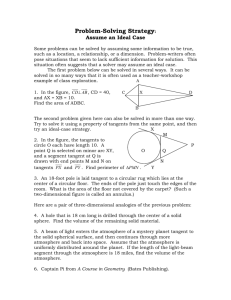

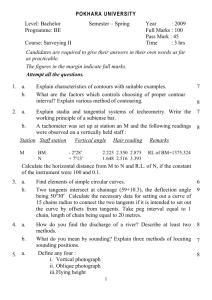
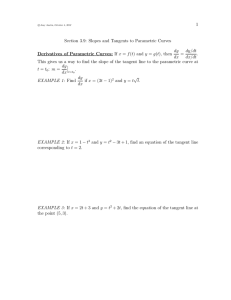
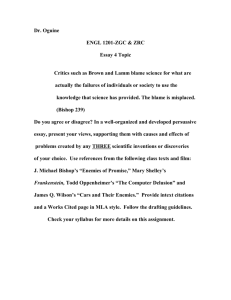
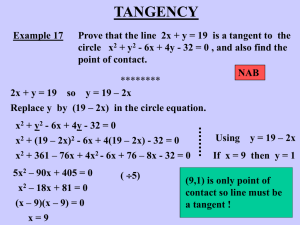
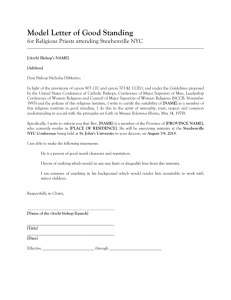
![An approach to answering the question about Elizabeth Bishop[1]](http://s3.studylib.net/store/data/008032916_1-b08716e78f328a4fda7465a9fffa5aba-300x300.png)